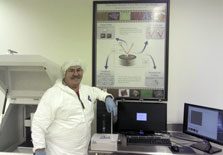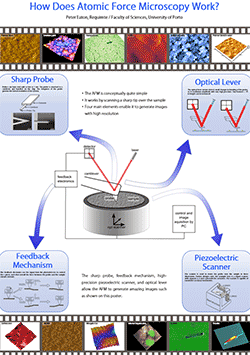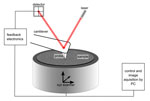I have this poster up in the AFM lab here. I made it to save me drawing out how AFMs work everytime I need to explain it to new students or visitors! I saw someone photographing it the other day, so I though I'd make it available here. Click the image below to get the .pdf of the full poster.
If you print this out and put in your own lab, please send me a photo of the lab! If you do want to print it, you can always This email address is being protected from spambots. You need JavaScript enabled to view it. for a higher-resolution version! The images in this poster are all my own work, and cannot be reproduced except for the purposes described here. UPDATE: Pleased to see the poster in situ in Edward Basgall's microscopy lab at Drexel University in Philadelphia, Thanks, Ed! See below.

- Details
- Hits: 17661
UPDATE: The site has been upgraded to new back-end code. This should help stability and enable new features in the future. Hopefully all the old pages are working now on the new code. If you see any problems, let me know!
The design of the site was changed a little, it looks kind of plain now, maybe I'll revert to the old look later.
There is now a new AFM Image Gallery, which contains more images than before, organised in categories and a few by instrument.
- Details
- Hits: 6801
Many people have asked me for a copy of this simple figure, showing how the AFM works. It's available for download below as a high quality .ppt file.
Please note the image is copyright 2010 Peter Eaton, and permission is given only for academic and educational use, excluding publishing. Please contact me if you want to use any other images on this website.
- Details
- Hits: 21973
As discussed in the appendices A and B of my book, reference and calibration samples are extremely important for AFM. Calibration samples allow the AFM to make accurate, quantitative measurements. Reference samples can be used for training, and certification, and just to check if the instrument (or the probe) are performing as they should. There's a list of commercially available calibration and reference samples here.
AFM piezoelectric scanners tend to change their responses and age over time, so it's necessary they they be recalibrated periodically (typically annually). All these repeated uses can lead to reference samples becoming dirty and contaminated. This leads to serious problems, because a contaminated samples cannot be properly used for calibration of an instrument, and may also be difficult to use as a reference sample. The article below explains some techniques that can be used to clean AFM calibration and reference samples. Note that this method o sample cleaning first appeared at AFMWorkshop.com. I learned the "NewSkin" method while visiting their headquarters.
- Details
- Hits: 53811
Subcategories
Page 18 of 21




